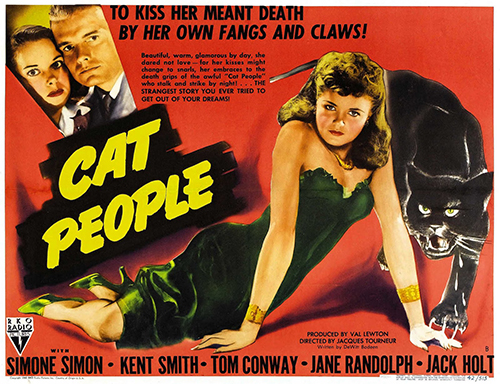Americans eager to forget distressing World War 2 newspaper headlines for a few hours were keen to let motion pictures facilitate that escape. At the same time, there was a subconscious desire to confront the menace and otherworldliness of the deadly conflict, peer into its darkest recesses, and contemplate its madness from the safety of a darkened movie theater.
Unsettling developments abroad played a part in why horror movies were so popular in the U.S. during the 30s and 40s. The genre brought great prosperity to the Hollywood studios as the tension overseas boiled up and became war. B-movies about the dead, the diabolical, and the deranged could be produced very cheaply, released to substantial box office numbers, and achieve impressive profit margins.
Some horror cinema relics from the 30s and 40s are widely celebrated today, most notably the Universal monsters. The studio expertly branded and franchised their B-movie creatures, and continue to merchandise them heavily today… so horror fans are not likely to forget about Frankenstein’s monster, the vampire Dracula, the undead Mummy, the Wolf Man, or the Creature from the Black Lagoon. Universal didn’t just make great low-budget horror films, they put on screen monsters that achieved a major cultural impact and are still recognized, if not treasured, by today’s mainstream.
The mainstream is less familiar with another string of highly-profitable horror movies from the same era. Nine films produced by Val Lewton for RKO are cherished by many avid film fans, but in general they may be some of cinema’s most underrated and underappreciated genre contributions. These gems (which were created to compete with the Universal monster flicks) include Cat People (1942), I Walked With A Zombie (1943), The Body Snatcher (1945), and Isle Of The Dead (1945).
Film producer Val Lewton was born in Russia in 1904, moved with his mother and sister to Berlin in 1906, then came to America in 1909. Growing up, he found success as a novelist and newspaper/magazine writer. In 1933, he went to work for film producer David O. Selznick, primarily as a story editor. Under Selznick, Lewton also functioned at many other levels of the film production process, usually without receiving screen credit. After toiling in these trenches for nine years, Lewton was hired by RKO to take charge of their new horror film production division.
RKO insisted that Lewton’s horror product lean toward the lurid and pulpy, and be saddled with attention-demanding titles and garish poster art. These demands were skillfully circumvented, however, and the producer managed to create brooding, atmospheric, dramatic, intelligent, and poetic cinematic excursions into the shadows. (The films’ nutty titles and flamboyant poster art remained.) Friction between RKO and the defiant producer dissolved when the movies proved unexpectedly profitable. Made on about one fifth of the budget of the average Universal horror picture, Val Lewton’s exceptional films were the outcome of the filmmaker’s intense drive, incomparable talent, consuming obsession, sleepless nights, and unrelenting stress. He was unwaveringly determined to create the best possible films with the resources he’d been given.
His success as a B-movie producer at RKO granted Lewton upgrade to a few “A-films” – but health problems, studio politics, and the interference that comes with bigger budgets made these experiences maddeningly pointless compared to his RKO horror work. The resulting “A-films” were financial and artistic duds – essentially ignored and quickly forgotten.
Outside of the nine horror movies Lewton cranked out for RKO, he only produced five other films. Two were low-budget missteps he made at RKO: the studio censored, re-edited, shot new scenes for, and otherwise mangled Youth Runs Wild (1944), and they tasked Lewton with producing Mademoiselle Fifi (1944), allegedly the lowest-budgeted period piece ever made by a Hollywood studio. The other three films were Lewton’s big-budget disasters: My Own True Love (1949) for Paramount, Please Believe Me (1949) for MGM, and Lewton’s only color film, Apache Drums (1950) for Universal.
Lewton pushed himself to physical and emotional exhaustion – on the films that went into production, as well as many other films that didn’t. This pummeled the man’s health. He suffered his first heart attack at the age of 42. He was dead at 47.
Dedicated to being a producer, Lewton never directed a movie. There are no known audio recordings or motion pictures of him. Lewton’s RKO horror movies were released to mixed reviews, but they were highly profitable, and today are acclaimed by critics as imaginative and masterfully-executed classics of suspense. Overworked, underpaid, underappreciated, and second-guessed throughout his career, he was never able to gain the faith of the industry he worked in – but hindsight reveals Val Lewton to be one of the great powerhouse talents in horror cinema history.
– See more at: http://www.fearnet.com/blogs/surviving-cinema/val-lewton-part-1-2#sthash.rF5MNAFR.dpuf

